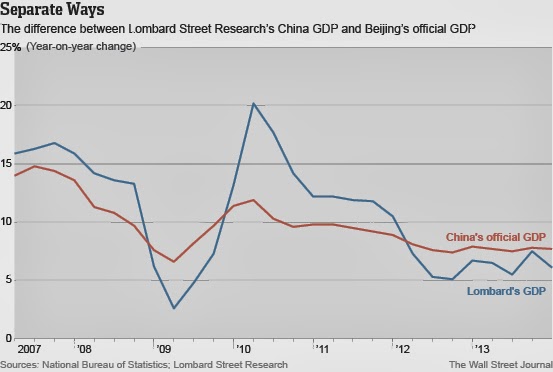China’s official GDP amounted to 56.9 trillion yuan (9.3 trillion US dollars) in 2013. However, the aggregate of the provincial GDP figures, which were independently calculated and released, was about 2 trillion yuan more than the 56.9-trillion-yuan figure arrived at by the NBS, even though three of the 31 localities that were yet to release the figures were not included.
This has aroused suspicion among Chinese netizens that some growth-obsessed local officials have cooked the books. Actually, the combined economic output of China’s provinces has long exceeded that of the national level compiled by the NBS.
For 2011, the aggregate GDP figure of all localities was 4.6 trillion yuan more than the NBS tally of 47.1 trillion yuan. In 2012, the aggregate figure was 5.76 trillion yuan higher than the total of 51.93 trillion.
Nextbigfuture notes that there are several ways that it is tough to get an exact read of China’s economic size.
1. There is shadow economy where people hide bribes and other activity and this could add about 15% to China’s economy
2. The currency is generally accepted to being manipulated and held to a lower value than it would otherwise be. If this changes in the future then China will rapidly become larger in exchange rated terms
More observations from Jim O’Neill of Goldman Sachs
Even though it is “slowing”, don’t forget it has become twice the size of Japan and that happened before the end of 2013, two years earlier than I and my Goldman Sachs colleagues first suggested when we said China could become the second largest economy in the world.
And wait for this one. Since the end of 2008 – the so-called “Great Recession” – China’s US value of GDP has doubled. At the end of 2008, it was about $4.5 trillion, according to the latest data. So, during the past five years, when the US and Europe have struggled to come to terms with the scale of the shock and its consequences, China has doubled in size.
If it were to double again in the next five years, it would take it close to a $20 trillion economy, and, five years on from that, another doubling would have it close to $40 trillion. This would make it much bigger than the US and would have happened earlier than my colleagues and I predicted – we forecast it would not happen until 2027.
So, when people tell you that China is slowing, please ask them to put it into some kind of perspective. It is probably true that China’s GDP is not likely to double every five years, indeed, it is probably more likely to be doubling somewhere between every seven and 10 years now, but this would still make it as big as the US by 2027.
To add to its importance, but also the complication in trying to fathom the place, there is also evidence that China is changing rapidly. The Chinese authorities are working hard to create a “new” China based more on the quality of growth and less on the quantity.
In the 2013 GDP accounts, the authorities said that the service sector has become larger than the manufacturing sector, a major development and one that ensures the winners and losers in the future will be different from those of the past. It is very important for all our actual, and potential exporting companies, to think about this.
I track the relative performance of retail sales, adjusted for consumer prices, relative to industrial production, as a guide to the changing nature of the economy. The latest monthly data show that industrial production slowed to 9.7pc, confirming the softer real GDP growth. The real, inflation-adjusted retail sales figures showed an improvement to 12.3pc, the strongest since the end of 2012, which was just before the government embarked on the aggressive clampdown on illicit gifting.
So there are some tentative signs that the strength of the consumer is broadening despite the overall slower rate of GDP growth and the tougher regime being imposed on those at the top.
The challenges facing China remain immense but the opportunities for them, and the rest of us, remain simply staggering.
US GDP at the end of Q3 2013 on an annualized basis 16,9 trillion. The official US GDP for the yearend of 2013 should be released at the end of January with an estimate and then with more adjustments in February. China is about 54.5% of the US economy (when Hong Kong and Macau are not included and about 56.7% when they are included)
If you liked this article, please give it a quick review on ycombinator or StumbleUpon. Thanks

Brian Wang is a Futurist Thought Leader and a popular Science blogger with 1 million readers per month. His blog Nextbigfuture.com is ranked #1 Science News Blog. It covers many disruptive technology and trends including Space, Robotics, Artificial Intelligence, Medicine, Anti-aging Biotechnology, and Nanotechnology.
Known for identifying cutting edge technologies, he is currently a Co-Founder of a startup and fundraiser for high potential early-stage companies. He is the Head of Research for Allocations for deep technology investments and an Angel Investor at Space Angels.
A frequent speaker at corporations, he has been a TEDx speaker, a Singularity University speaker and guest at numerous interviews for radio and podcasts. He is open to public speaking and advising engagements.



